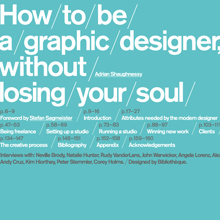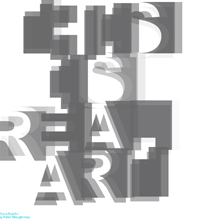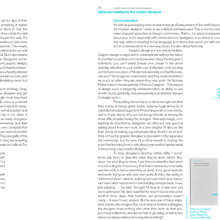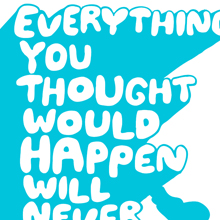
Adrian Shaughnessy
January 25, 2006
by Jason A. Tselentis
Speak Up: Typographically, the book is beautiful. Because it’s light on image and heavy on text, you really worked every detail of the type, from the headers to footers to captions; and then there’s the book’s cover, which heightens the laboratory/textbook feel. This being your first book, what were your aesthetic influences?
Adrian Shaughnessy: I’m glad you like the design. I was determined to make the book a striking visual statement. But I must point out that I didn’t design the book myself. I thought about doing it, and came to the conclusion that writing and designing would be too much. So, I asked some friends of mine to do it. Bibliotheque are a newish studio. They’ve been going for about two years. There are three of them. I’ve known Jon Jeffrey for some time, and I’ve come to know the other two (Mason Wells and Tim Beard) since doing the book. I chose them because they have pedigree (Jon is ex-Farrow, and Mason and Tim are ex-North), and because they are designers/typographers with the sort of commitment to detail that I admire.
Every line of the justified text is hand adjusted to get the spacing right. The design has the sort of Modernist functionality that I wanted, but also a bit of contemporary swagger. Of course, we had some disagreements along the way: but nothing that didn’t improve the book in the end. Their newness as a studio helped inform the book. They were less than a year old when they started work on it, and many of their experiences and observations helped shape my writing. Also, I was their client – and that was interesting, as I’d never been a client before. I learned a lot from working with them, and some of it found its way into the book.

|
At various points in my life, design has suddenly seemed unimportant.
Yet, I’ve always managed to rekindle my interest, and despite a few ‘bust-ups’ I’m still in love with graphic design.
|
 |
|
|
|
|
|

SU: Passion seems to be a consistent theme in the book, and you provide a wealth of information to further designers’ passions. Why do you feel designers must maintain passion throughout their careers?
AS: I think passion has become a bit of a graphic design cliché. It is often used to mean stubbornness, or narrowness, or insularity. I try to use the word to mean a love of graphic design. By that I mean maintaining the excitement you had when you first encountered design. But that’s not an easy thing to maintain. At various points in my life, design has suddenly seemed unimportant. Yet, I’ve always managed to rekindle my interest, and despite a few ‘bust-ups’ I’m still in love with graphic design.
Paradoxically, I think passion is best maintained by having an interest in the world beyond graphic design. One of the reasons why graphic designers have a poor public image is because they are often seen as only being interested in graphic design. The best graphic designers are not obsessed with graphic design to the exclusion of everything else. I also think that the best graphic designers have what I’ve called in the book ‘cultural awareness’. The thing I like best about being a designer is moving from one subject to another. But you can only do this if you have an awareness of what is going on in the world.
SU: Then you have designers that insist to independently work on what you call self-initiated briefs. During these excursions, they may have a passion for nobody but themselves, entertaining their own initiatives and ambitions. Why do you think designers become tempted by this masturbatory means of creating?
AS: I’d never tell any designer what they should or should not do – if writing your own briefs is personally rewarding, then do it. But I think there is something in the graphic designer’s psyche that is predisposed (either through education or psychology) to require an external brief. If we look at all the great design from the past century, we’ll see that it was all done to a brief. I don’t think this is in conflict with the idea of the designer having a voice. Design that denies the designer’s voice is either purely functional (therefore perfectly valid) or somewhat dull. If you don’t need a brief, then you are probably not a graphic designer. The brief is what distinguishes designers from artists.
Having said that, I think there are a lot of people working in the hinterland between art and design. I’m thinking of people like Daniel Eatock in England, and many of the graduates from the RCA over the past 10 years. Eatock switches back and forth between work without a brief, and work with a brief. Perhaps graphic design will evolve to a point where the brief becomes redundant? At the moment, the only universal definition of a graphic designer is someone who works to a brief – and that includes self-initiated briefs.
SU: In your chapter dedicated to self-promotion, you touch on the celebrity issue that has surfaced. I agree that we depend on our reputations to maintain work and get new clients, but things seem to have gotten out of hand. Why have so many designers been lured by celebrity instead of simply making good work?
AS: The world is obsessed with celebrity. Perhaps it always has been: I suppose the difference today is that that because of the all pervasiveness of always-on electronic and print media we find it easy to become obsessed with people we’ve never met, people who are often famous for nothing other than being famous. I don’t think design is even close to that situation yet. ‘Celebrity’ in design is still predicated on excellence of work. Of course, there are things designers can do to promote themselves as design-world celebs – produce monographs, go on the lecture circuit, sound off in the magazines – but the opportunity to do these things is only given to those who have achieved something measurable.
So, when I talk about celebrity in design, I’m not talking about the sort of celebrity that’s chronicled in the glossy magazines you buy in supermarkets. I think what I’m getting at is that when I became a designer in the mid-seventies, absolutely no thought was given to the notion of fame. Yes, there were famous designers, but they seemed like well-kept secrets; you knew their work, but not much else about them.
Today, every designer knows that they can achieve a certain sort of fame. I don’t even think there’s anything wrong with this – it might even be a useful spur to good work. But if it replaces good work as the ultimate goal of the designer, then I think it is a dangerous cul de sac. I also think that certain designers have become adept at building their own myths. I’m thinking of the way that many graphic designers who came into contact with the music business, learned how to spin their own mythologies. The downside to this is that it creates the illusion of a grime-free existence. If we only read about superstar designers gliding from one lecture theatre to the next, from one perfect job to another, then we have a distorted view of the life of a designer.
It’s one of the reasons why I made Stephan Sagmeister the ‘patron saint’ of my book, I loved the way he exposes (wittily) the myth of design celebrity in his book Made You Look. That was a great inspiration to me.
SU: Elaborate on the statement that closes the Self-Promotion chapter, “If you want to be famous, the first thing you have to do is stop wanting to be famous.”

|
If you do good work, you will get noticed.
|
 |
|
|
|
|

AS: This relates to what I said in the last answer. If you do good work, you will get noticed. The design press has an insatiable need for good new talent to fill its pages. If you are any good, you’ll be found. So, concentrate on the work.
SU: If “The correct relationship between a designer and his or her portfolio is one of constant doubt and questioning,” how can designers prevent themselves from analysis paralysis? Thinking so much that they fail to reach a level of satisfaction?
AS: Well, self-satisfaction is a sort of poison. Complacency kills. I don’t think you can ‘think too much’. Clearly if you’re wracked with self-doubt and anxiety, you are going to find life difficult. But questioning yourself – and your work – is healthy. This is true of life, as much as it is of graphic design. But of course with self-analysis comes a certain amount of pain, yet this needn’t be a bad thing.
SU: You stated that designers must possess humanistic qualities—they must have a voice—and I agree that we should be more than just a set of hands. IDEO has labeled their ideal team member a ‘T-shaped’ person, where there is one deep level of knowledge complimented by a wide spread appreciation for varying subject matter. How does that label compare to your idea of a designer’s attributes?
AS: I defined the key attributes of a graphic designer as communication skills, cultural awareness and integrity. Obviously, talent is important, but the good thing about graphic design is that it allows a very generous definition of talent. There is room for all sorts of talent – we can be good at only one tiny thing and still find a way of becoming an effective graphic designer. But for me, designers have to be able to communicate (both through their work and the way they talk about their work); they have to have cultural awareness (see above); and they need integrity. Integrity is the difficult one here. What does it mean in graphic design? I’ve been criticized by an English reviewer for not taking a hard line on ethical questions in the book. I deliberately refused to do this. Political and ethical decisions are matters of personal conviction – I’m not going to presume to tell people how they should run their lives.
But by integrity I mean being honest in the way you deal with the people you inevitably, as a graphic designer, come into contact with. And I also mean believing in something. This can be an aesthetic, a political or a pragmatic belief, but you have to be prepared to stand up for something. If you don’t believe in anything, no one will believe in you.
My main reason for writing this book was my frustration with designers who say – I don’t get any good work. I wanted designers to realize that we can’t go through our working lives blaming clients and the economic climate for our poor work. We have to take responsibility for the successful outcome of a project, and to do this we have to show integrity. It’s a bit glib, but I divide designers into heroes or doormats. And the difference between heroes and doormats is usually integrity.

|
 |
|
 |
|
|
|
|

SU: How else can designers distinguish themselves, especially if it’s right out of school and they’re trying to find work?
AS: I’m amazed at how ill-prepared for working life many young graduates are. In the book I go into a lot of practical details – portfolios, interviews, etc – but really what I’m talking about is designers acquiring the ability to see objectively. I’m appalled by the self-absorption of many designers (I can spot this because I’m often guilty of it myself!) As someone who has employed dozens of designers, I’m always won over by intelligently presented work. The way young designers present themselves often says more about them than the work they show. It is a sure sign of potential.
SU: One thing I really enjoyed was how you nicknamed certain elements: Factor X (the reason clients come to designers) and the McGuffin (the essence of every creative brief). Doing so emphasized how important these things are, because without labels, they’re just ideals or unspoken rules. Throughout your design career, how did you go about identifying these things? By accident?
AS: Yes, labeling was a way of drawing attention to mundane factors we take for granted. It’s something ad agencies do – they always give the films they are working on a name. It makes them real for everyone.
SU: In your book, you address many factors that designers take for granted relating to presentations, building a portfolio, and relating with clients. Overall, it’s a rich collection of anecdotes and lessons, and now in retrospect what do you wish you included but didn’t?
AS: The biggest regret I have is that I’ve only included a fraction of what I’d like to include. When I got to the end of the book, my only desire was to rewrite it. Before writing the book, the longest pieces I’d written were a few essays of around 4-6000 words. This was 60,000 words, and I learned a lot doing it. This is a long-winded way of saying that I’m itching to do a second edition. My publisher seems keen, so I’m going to get a chance to put in some of the things I missed out. I’d certainly like to expand on the creative process section – I’ve thought a lot about that since, and I’d like to make that more substantial.
SU: Thanks, Adrian
All images taken from How to Be a Graphic Designer Without Losing Your Soul, available by Princeton Architectural Press.
Adrian Shaughnessy is a self-taught graphic designer. Until recently he was creative director of Intro, the London-based design company he co-founded. He left in 2004 to pursue an interest in writing and consultancy, and is currently consultant creative director of This is Real Art, a 'virtual' design company. Shaughnessy has written three books on design for music (the Sampler series) and edited a book of Intro work. He writes for many of the leading design publications, and is a contributor to Design Observer and The Wire. He lectures extensively around the world, and in January 2006 he was appointed editor of a forthcoming magazine devoted to illustration.

This interview has been conducted exclusively for Speak Up.
Reproduction without our written consent is strictly prohibited. Please if you would like to use it for educational purposes or if you are interested in other means of reproduction. Thank you for your understanding.





